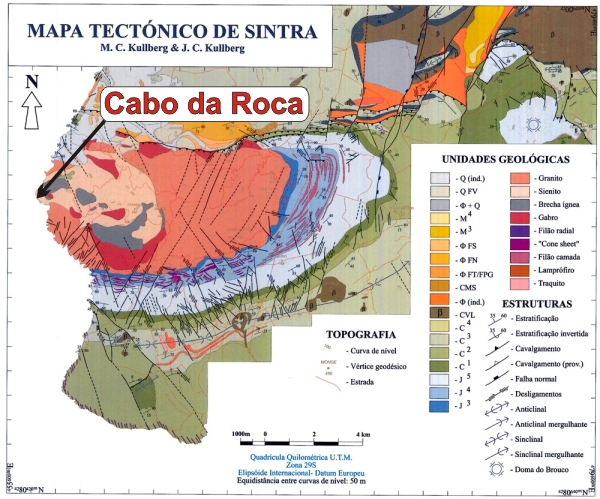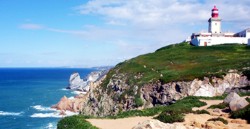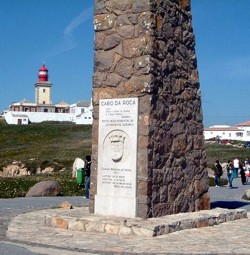
From the guidelines, as from January 2013: "People do not need to wait for permission to log your EarthCache. Requiring someone to wait is not supported by the EarthCache guidelines. People should send their logging task answers to you, then log your EarthCache. When you review their logging task answers, if there is a problem, you should contact them to resolve it. If there is no problem, then their log simply stands."

Cape Roca (Cabo da Roca) is located in the Lisbon district, 40 kilometres west of the city of Lisbon and 18 kilometres west of the town of Sintra. Its coordinates, 38°47'N 9°30'W, are inscribed on a stone plaque on the monument at the site. The cliff rises out of the Atlantic Ocean to approximately 140 metres above sea level.
This is the westernmost point of Europe and sees a steady stream of local and foreign visitors year round as the views from the location are magnificent if the weather holds.
Cabo da Roca has been described by Luís de Camões (c. 1524–June 10, 1580), a famous Portuguese poet, as the place "where the land ends and the sea begins" (Portuguese: Onde a terra acaba e o mar começa).
The cape hosts a coffee and tourist memento shop as well as a lighthouse that was completed in 1772.
Around 90 million years, in the Upper Cretaceous period, a body of less dense granitic magma ascended through the existing Jurassic lithologies (essentially limestones) and solidified creating what is now known as the Sintra Massif or batholith. It is a circular intrusion that is made up of a central syenitic ring surrounded by an outer, large, granitic ring and a discontinuous outer gabbro-diorite ring that is better exposed in the south.
This disposition reflects the installation of two distinct diapirs: the first of granitic composition with crustal affinities and the second of gabbro-syenite composition (syenite is really a rock with a similar composition to granite but with very little quartz) with mantle affinities occupying the nucleus of the first diapir (see the geological map).
Cabo da Roca is more or less centered in this inner nucleus of gabbro-syenite affinities. The Cape itself has been formed due to the collapse of (half?) of that gabbro-syenite nucleus into the sea. If you observe the geological map you can see that the inner ring is truncated in the west. Quite simple if you think about it.
 To claim credit for this cache you will have to prove that you were at the site by measuring the dimensions of the largest, rounded outcrop of syenite located 3 m NE of the monument within the oval, stone paving surrounding the monument (see image) and why don't you upload a nice picture of you or your team standing in front of the plaque that gives the coordinates of Cabo da Roca? Enjoy the views.
To claim credit for this cache you will have to prove that you were at the site by measuring the dimensions of the largest, rounded outcrop of syenite located 3 m NE of the monument within the oval, stone paving surrounding the monument (see image) and why don't you upload a nice picture of you or your team standing in front of the plaque that gives the coordinates of Cabo da Roca? Enjoy the views.
This cache is part of a series related with the geology of the Sintra Massif. If you would like to know more about and see the effects of the intrusion of this batholith then have a look at:
Upheaval at 90 million years - DP/EC4 ; Complex Geometry - DP/EC28 ; "X" - DP/EC31
Source: Kullberg, MC and Kullberg, JC, 2000. Tectónica da região de Sintra. In: Tectónica da região de Sintra e Arrábida. Mem. Geociências, Museu Nac. Hist. Univ. Lisboa, nº 2, 1-34.
The idea for this cache goes to fellow geologist H. Santana.

O Cabo da Roca, com um altitude de 140 metros acima do nível do mar, faz parte da costa marítima portuguesa, localizando-se na freguesia de Colares, no concelho de Sintra e distrito de Lisboa.
As suas coordenadas geográficas são N 38º47', W 9º30', o que faz do cabo o ponto mais ocidental do continente europeu, ou, como escreveu Luís de Camões, o local “Onde a terra se acaba e o mar começa” (in Os Lusíadas, Canto III).
 Um padrão em pedra com uma lápide assinalam esta particularidade geográfica a todos quanto visitam este local. A sua flora é diversa e,
Um padrão em pedra com uma lápide assinalam esta particularidade geográfica a todos quanto visitam este local. A sua flora é diversa e,  em muitos casos, tem espécies únicas, sendo objecto de vários estudos que se estendem, igualmente, à geomorfologia, entre outros.
em muitos casos, tem espécies únicas, sendo objecto de vários estudos que se estendem, igualmente, à geomorfologia, entre outros.
Estando inserido numa zona de fáceis acessos e de grande afluência turística, são muitas as pessoas que o visitam.
Approximadamente há 90 milhões de anos, durante o Cretácico Superior, um corpo de magma ascendeu empurrando para cima as litologias calcárias do Jurássico. O batólito de Sintra; intrusão circular composto de um anel exterior gabro diorítico e de um núcleo de gabro sienítico (ver mapa geológico), domina a morfologia da Serra de Sintra.
O Cabo da Roca situa-se aproximadamente no centro do núcleo gabro sienítico (um sienito é basicamente um granito mas com muito menos quartzo) e foi formado devido ao colapso de parte deste núcleo dando origem às falésias verticais 140 m acima do nível do mar.
 Para acrescentarem esta cache ao vosso espólio de “founds” vão ter de provar que estiveram no local medindo as dimensões do afloramento de sienito que está localizado 3 m a NE do monumento do Cabo da Roca no limite do pavimento de pedra oval que circunda o monumento (ver imagem) e incluindo no vosso log uma imagem em frente ao monumento que assinala o Cabo da Roca.
Para acrescentarem esta cache ao vosso espólio de “founds” vão ter de provar que estiveram no local medindo as dimensões do afloramento de sienito que está localizado 3 m a NE do monumento do Cabo da Roca no limite do pavimento de pedra oval que circunda o monumento (ver imagem) e incluindo no vosso log uma imagem em frente ao monumento que assinala o Cabo da Roca.
Esta cache faz parte de uma série assinalando os efeitos da intrusão do batólito de Sintra. Se quiseres vêr e saber mais sobre os efeitos do mesmo, vê :
Upheaval at 90 million years - DP/EC4
Complex Geometry - DP/EC28
"X" - DP/EC31
Bibliografia: Kullberg, MC and Kullberg, JC, 2000. Tectónica da região de Sintra. In: Tectónica da região de Sintra e Arrábida. Mem. Geociências, Museu Nac. Hist. Univ. Lisboa, nº 2, 1-34.
A ideia desta cache provém da colega e geóloga H. Santana.

 The most exciting way to learn about the Earth and its processes is to get into the outdoors and experience it first-hand. Visiting an Earthcache is a great outdoor activity the whole family can enjoy. An Earthcache is a special place that people can visit to learn about a unique geoscience feature or aspect of our Earth. Earthcaches include a set of educational notes and the details about where to find the location (latitude and longitude). Visitors to Earthcaches can see how our planet has been shaped by geological processes, how we manage the resources and how scientists gather evidence to learn about the Earth. To find out more click HERE.
The most exciting way to learn about the Earth and its processes is to get into the outdoors and experience it first-hand. Visiting an Earthcache is a great outdoor activity the whole family can enjoy. An Earthcache is a special place that people can visit to learn about a unique geoscience feature or aspect of our Earth. Earthcaches include a set of educational notes and the details about where to find the location (latitude and longitude). Visitors to Earthcaches can see how our planet has been shaped by geological processes, how we manage the resources and how scientists gather evidence to learn about the Earth. To find out more click HERE.

